
I don’t know the last time I flew somewhere to visit a mall.
But I’m here in King of Prussia, Pennsylvaina—a Philadelphia suburb—walking around a vast shopping complex that’s seemingly frozen in the ‘90s. Despite it being 11 a.m. on a Friday, cars whizz by to fill the endless parking lots, perhaps to peruse the Nordstrom or grab lunch at The Cheesecake Factory.
A few years ago, I’d be looking up at a two-story Lord & Taylor. But instead, that big box retailer has been transformed into the next big bet in the experience economy: the inaugural Netflix House.
Netflix has been experimenting with expanding its digital footprint into IRL since 2020—welcoming millions of people for live events like Bridgerton’s Victorian ball. But Netflix House is the company’s first permanent physical location. It’s spent the past two years working with the global architecture firm Gensler and a handful of other companies to imagine what Netflix could be as a venue. I was invited as one of a handful of journalists to peek inside before it opens to the public this week.
As I walk through the front door—a door cheekily framed by a classic red Netflix DVD mailer—a large atrium welcomes me. I’m ushered forward by a long, painted red carpet that leads straight up the stairs in an entrance that ironically feels more Hollywood than Hollywood.
On the walls, you’ll see every Netflix thing you know—a 10-foot Thing hand from Wednesday, a spooky mansion from Stranger Things, an upside down, floating chess set from Queen’s Gambit.
But what is Netflix House?
My tl;dr version is that it feels like a cineplex for the modern era, but there’s only one theater inside—and that theater is actually free to attend. Instead, most of the 100,000+ square-foot footprint has been dedicated to amalgamating a millennial fever dream: a space that’s part arcade, part store, part mini golf, part restaurant, and—mostly—a love letter to experimental, immersive theater.
However, after two hours of working my way through Netflix House’s spaces and attractions, I realized that Netflix isn’t trying to reinvent the “outdated” movie theater for the streaming age.
Instead, Netflix wants to take over experiential retail the same way it took over video streaming.

Why build Netflix House
Say what you will about the streaming wars, but Netflix is still the juggernaut of the global market of its own creation. Its 301.6 million global subscribers approach the population of the United States (the last figure Netflix reported before it stopped sharing subscriber numbers at the end of 2024). When the company’s subscriptions began to plateau in 2022, the company finally dropped the ace up its sleeve, and cracked down on subscription sharing. Despite complaints, they added 70 million subscribers since.
It’s a testament to the power of the Netflix brand, and its IP. But despite the fact that Netflix owns cultural mindshare (how many Rumi costumes did you see on Halloween), Netflix continues to draw 95% of its revenue from subscriptions. It lacks a truly diversified business model.
Over multiple interviews, Netflix shied away from outlining its own plans for how Netflix Houses might drive the company’s bottom line. The company has committed to building three locations through 2027, and assures me that Netflix House is an idea that it intends to scale. “I would love to see this in every major city,” says Marian Lee, CMO of Netflix.
It would be silly for Netflix to not try. The global entertainment market (including broadcast and events) is a $3 trillion business globally according to PwC. Live experiences, ranging from concerts to podcast recordings to installations like 29 Rooms, are a growing phenomenon within that. The U.S. experiences market has been growing 21% a year since 2019, according to the research firm Habo.
In-person, experiential entertainment has been a big business for decades. Disney’s theme parks represent 37% of its $90 billion in revenue, while Universal Studios and Super Nintendo World drive about 20% of NBCUniversal’s $39 billion business. (It’s why the companies recently announced theme park investments of $60 billion and $7 billion, respectively.)
These figures dwarf Netflix’s $3 billion marketing budget from which Netflix Houses seem to have been developed thus far. However, Netflix’s approach isn’t to build a single global destination that will require families take out a second mortgage to visit; it’s to craft a duplicatable model. To build a sort of Netflixland inside large scale, oft-abandoned big box retail spaces that dot the U.S.—and perhaps nostalgic American malls in particular. It’s designed to be a cross between the classic cineplex and experimental theater, with enough new things to check out to keep up with Netflix’s relentless release cadence.
“We want it to be a place that’s not just like a special occasion destination,” says Lee. “We want you to come back over and over again.”
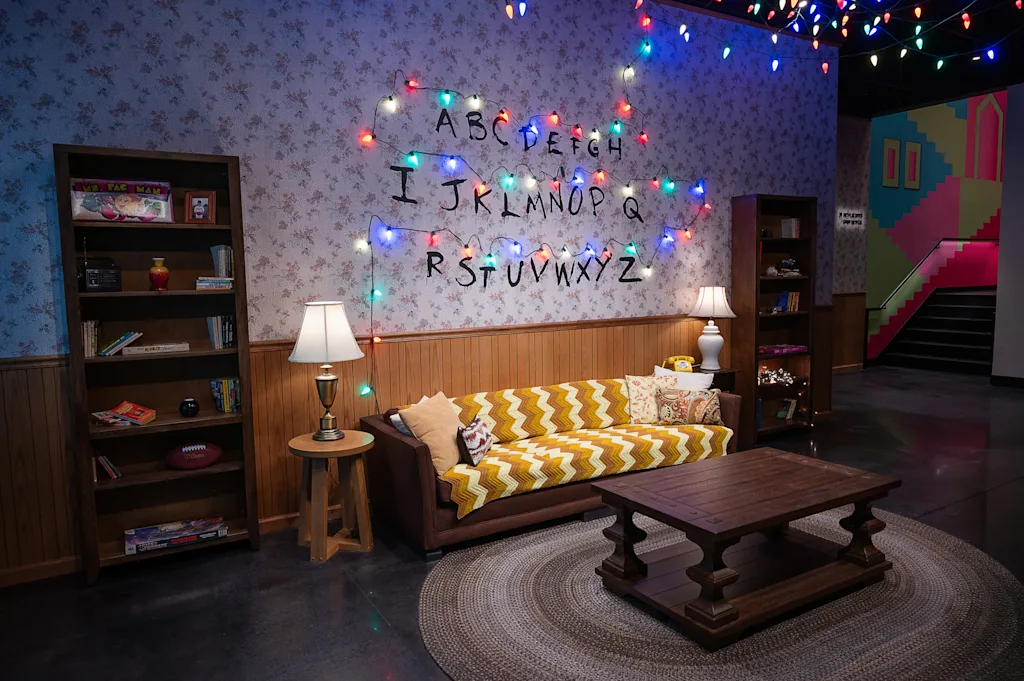
Modular by design
Interactive experiences are the big attractions at Netflix House. The company has been honing this idea for a while, having launched 40 experiences for brands like Stranger Things and Bridgerton globally. They’ve entertained 10 million people to date, at 450 openings in 300 cities around the world—learning what’s worked and what hasn’t.
“Every time we do it, it’s like, ‘Oh, that game’s not working as intended. Let’s change that,’” says Lee. “And so we are sitting on a mountain of information that allows us to put something into a permanent space, but we are still able to be flexible.”
Indeed, Netflix House is built to reshape itself to embrace its latest viral hit. Even its stunning atrium is decorated in swappable set pieces, some of which were updated in the last minute before opening.
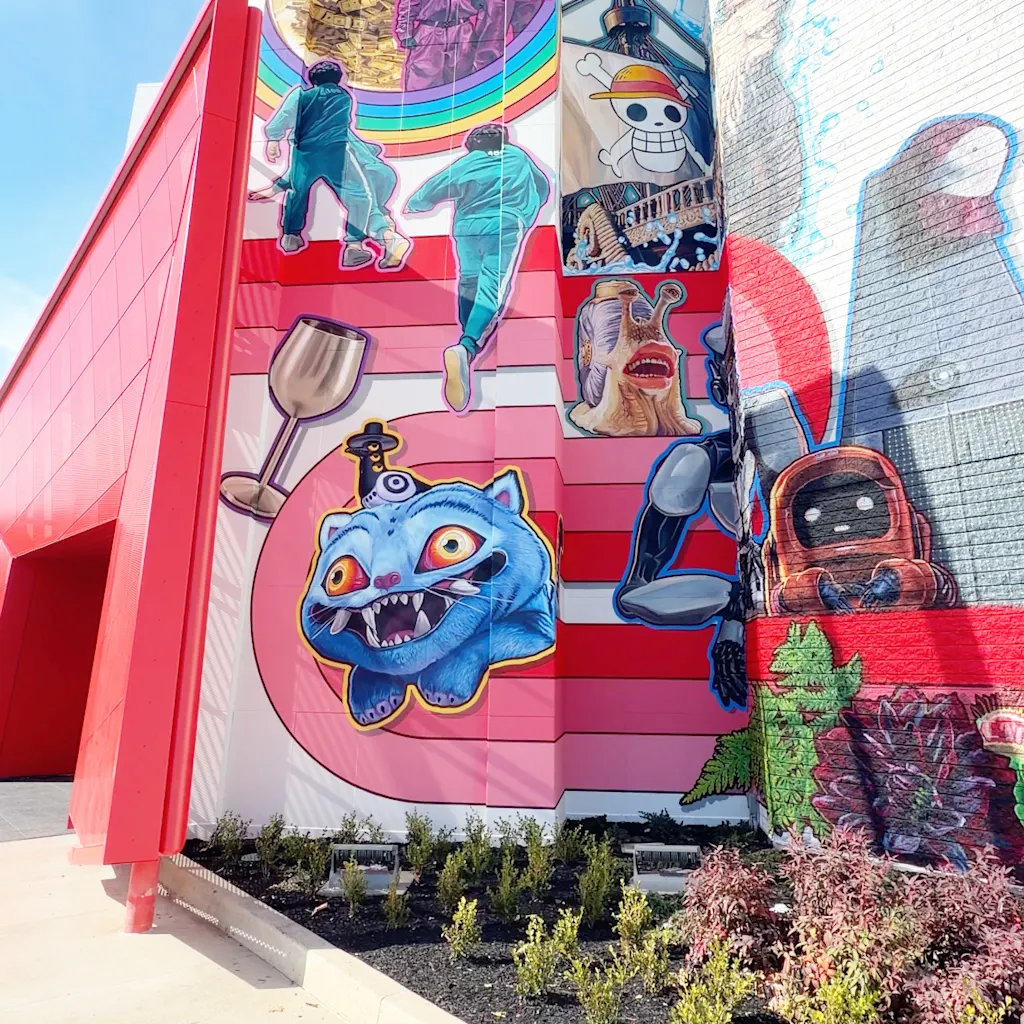
“The level of detail in the design…I really pushed this team to the brink,” says Lee, who notes that as K-Pop Demon Hunters was a surprise hit, Netflix needed to figure out how to get the IP integrated at the eleventh hour—adding the cat Derpy onto a mural outside, and commissioning a big sculpture that will sit outside the space. “They hustled and got it done. But we know that for fans who are walking through the mall and see Netflix, they know that that’s really [our] number one film in 2025. And so if we didn’t deliver for them, that wouldn’t be great.”
As Aaron Birney, Gensler’s principal of retail and consumer experience, explains, Netflix usually spun up events ad hoc in unique locations. That meant Netflix commandeered big box stores locally, like a closed Best Buy, and transformed them into a proper theater.
Similarly, Netflix House is architected to be a barebones frame that recedes behind the content. But it’s been designed with the acoustics, expansive rooms, and technical framework to enable anything Netflix might want to build inside.
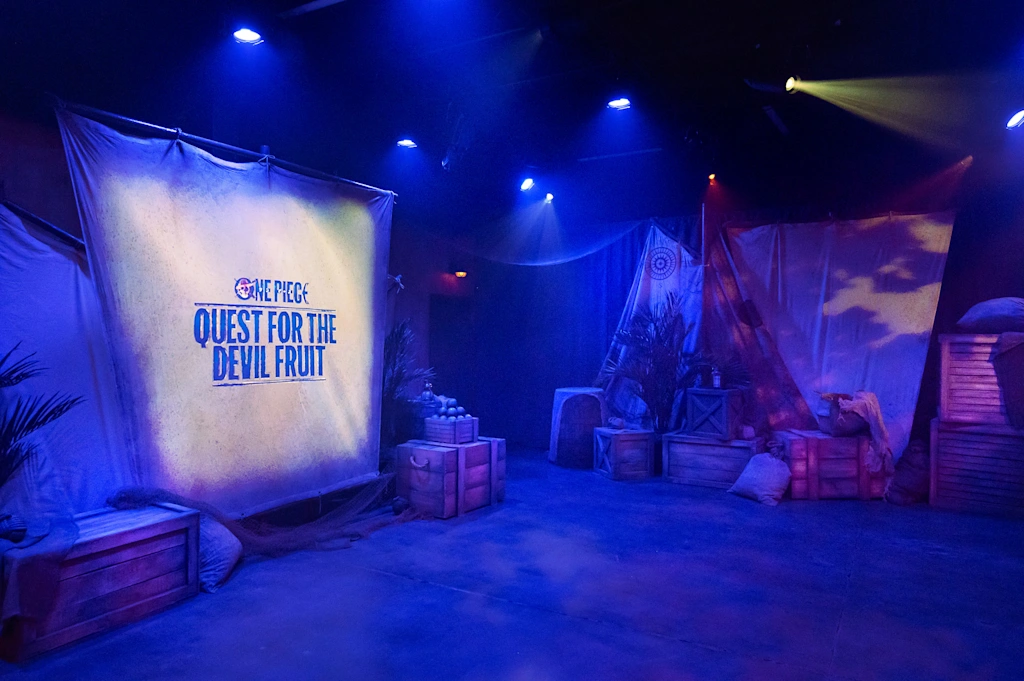
Trying Netflix’s experiences
At Netflix House, two 15,000 square foot sound stages represent a third of the overall footprint, each of which has been transformed into a different IP wonderland offering a different flavor of experience—complete with live actors who improv, and will even pull you aside, to round out the immersion. To book these experiences, you can simply scan a QR code and choose your time slot of choice.
The One Piece experience, for instance, begins with a member of the Navy locking your group up into a pirate prison cell. And what follows is a long series of escape rooms—each with a different puzzle or game. (I found myself running my hands over walls to push symbols at the same time, or turning cranks and switches—one challenge even forces your crew to band together their arms to stretch an electric current from one wall to the other). To manage capacity, two concurrent escape room tracks run at the same time, and doors open on a timer even if you suck. It’s a linear experience with one clear story.
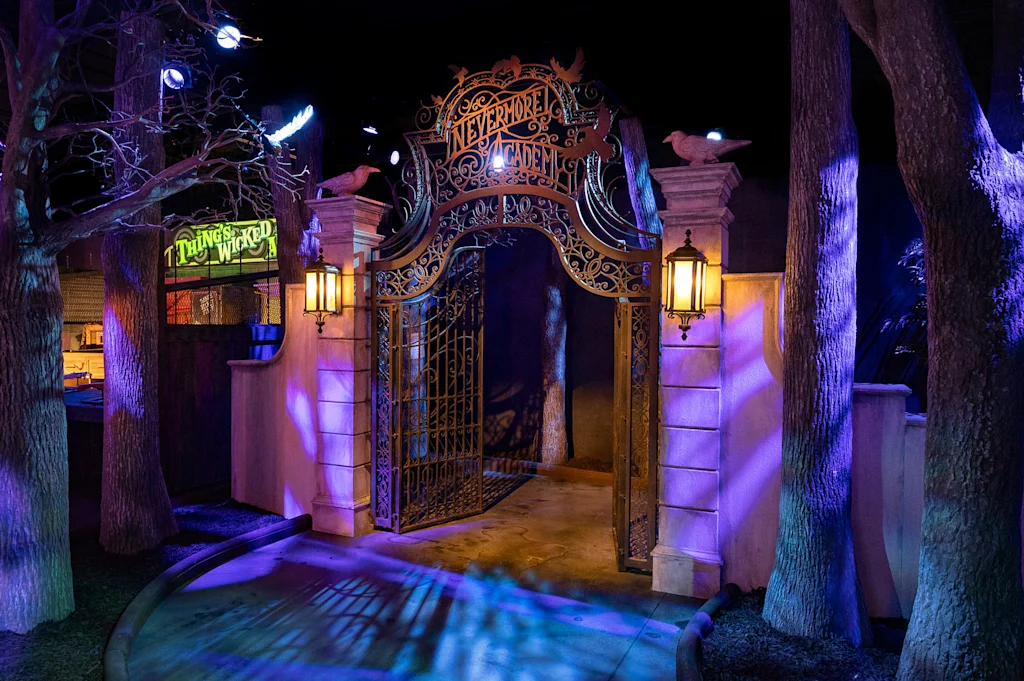
Wednesday’s exhibit is more freeform for you to explore as you like. It kicks off with a truly jaw dropping reveal as you step right into her bedroom—a transportive, picture perfect recreation of the show. Her bubbly roommate, Enit, appears with her in silhouette behind the large window to kick off the story. It opens to reveal a maudlin carnival (complete with a laser crossbow shooting range and spinning wheel that will reveal how you will die).
Instead of escaping, you’re there to play. But you can also follow along with a mystery on your phone…which will draw you deeper into Wednesday’s built world, from the carnival, through a forest, into more striking Wednesday sets like the headmaster’s office where you can hunt for clues.
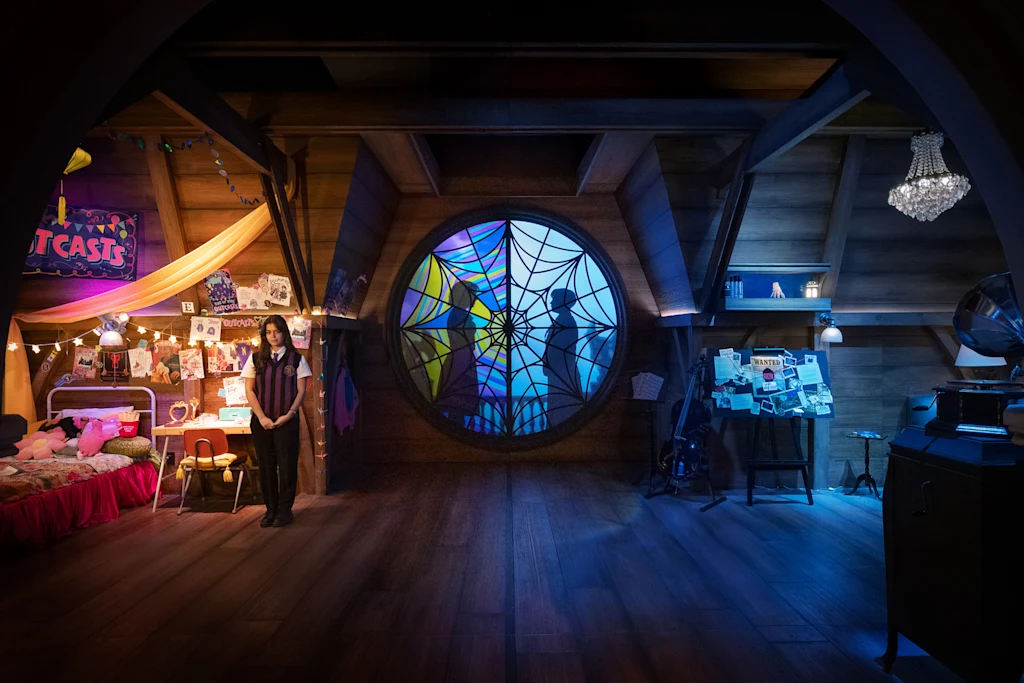
Netflix is coordinating with show runners so that the mini stories in these experiences feel like they are actually part of the world. And in some cases, the company is installing actual props from these shows—as with the lockers installed in a Stranger Things experience coming to the Dallas Netflix House when it opens later this month.
That installation gives everyone a large, dark space to explore with a specially programmed flashlight (that, yes, will go out at the worst of times). Dallas will also host real life Squid Games, which Netflix toured with, for fans to compete to win (death punishments not included).
Each of these experiences are ticketed separately, starting at $39/head, and they’ll actually be moved between Netflix Houses for regional variety. The company is insisting, however, that it doesn’t want to take a rinse and repeat approach. Netflix says it won’t simply reskin the existing spaces with different IP. Instead, the company is partnering with local artists and several technical experts so that each installation features a different experiential mechanism at its core.
Truth be told, it’s the sets that I found so appealing. To actually step inside a show is a powerful sensation. It’s more than just an Instagram opp (of which, yes, the House has many). You’re actually living a piece of entertainment IRL.

A theater that doesn’t charge
Perhaps the biggest twist inside Netflix House is its movie theater, which doesn’t charge for tickets. Instead, it’s a free programming space, where Netflix imagines people meeting up for Monday Night RAW viewing parties, or where actors might tour to promote a show.

It’s a coy bit of marketing, sure. (And you won’t forget it’s Netflix. Even the walls inside the theater are lined with red, glowing columns that mirror the Netflix slate preceding each show.)
But perhaps Netflix also knows that it’s another way to get people into the House. Some attractions are sponsored (which shouldn’t be a surprise)—I noted Mastercard logo adorning the wall near a Bridgerton photo opp—and there’s plenty of other stuff to spend money on when the show is over, too.
Because a considerable amount of the footprint goes to a retail store and a restaurant.
Not that it’s a competition, per se, but the store outperforms some retail I’ve seen at Disney World and Universal. I particularly enjoyed a sculpture where One Piece’s own Luffy spirals his rubber arm out of a barrel of tangerines to grab his hat. It’s hard to resist the endless array of merch, which includes regionalized “NetPHLix” sweatshirts and totes. Who wouldn’t want to binge Love is Blind while chugging Josh out of its official steel wine glasses?
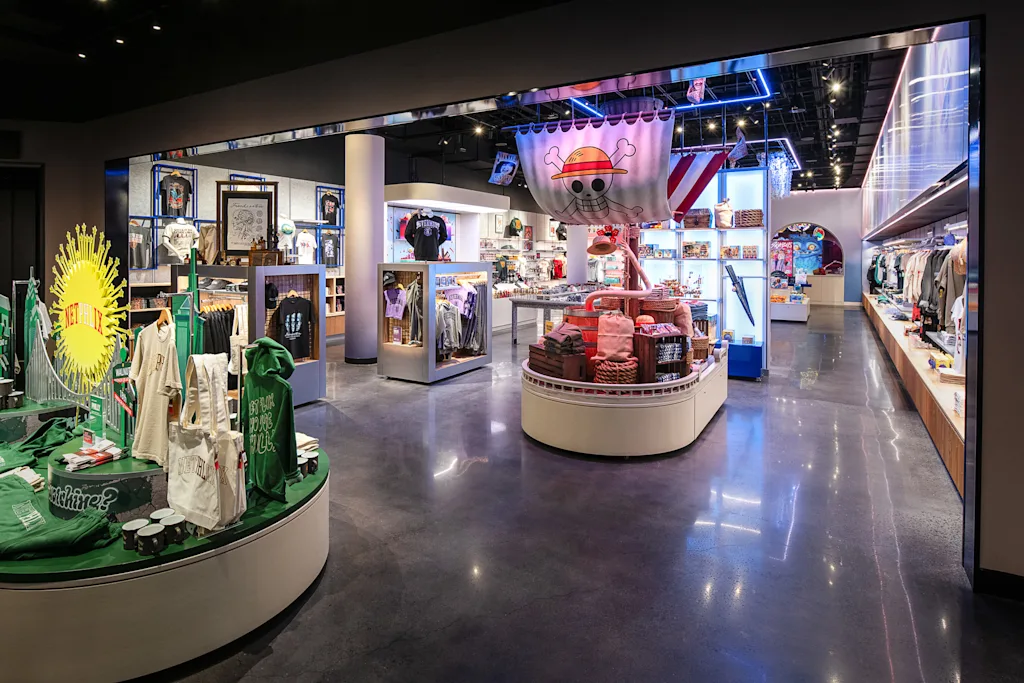
The restaurant called Netflix Bites, meanwhile, juggles a vibe between high touch entertainment and mall food court. Greg Lombardo, VP and head of live experiences at Netflix, says he’s after an “elevated diner concept.” The menu is amusing. It offers fan service items like Red Bite, Green Bite chicken referencing Squid Game, and a 2lb pretzel that celebrates how every Netflix story has a big twist.
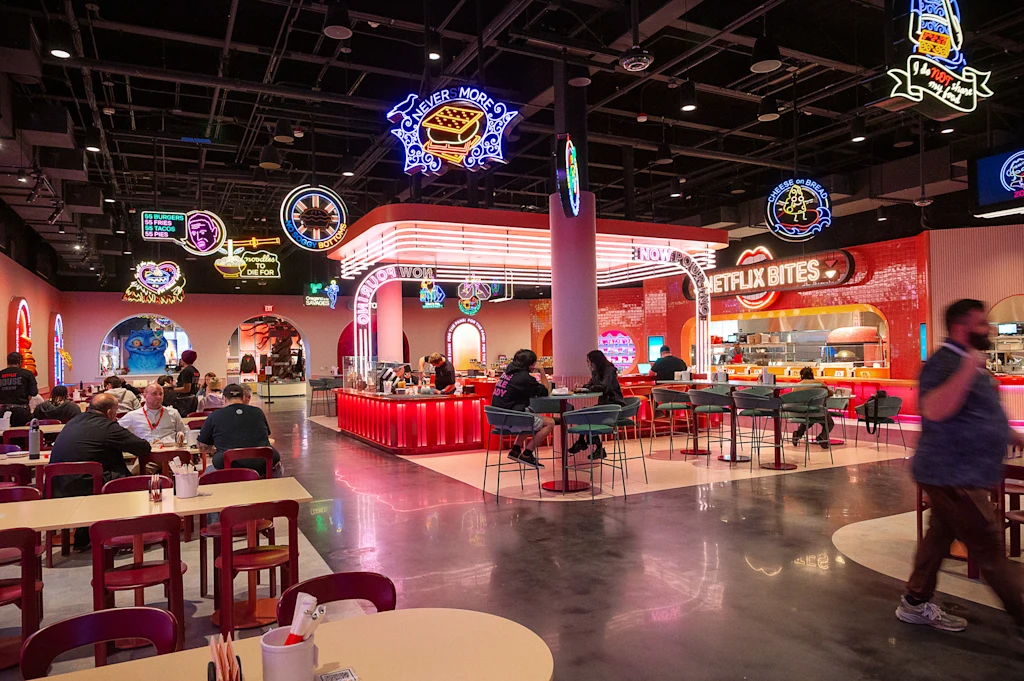
But it’s the custom neon signs and lovingly created sculptures (the Emily in Paris croissant dress is more exquisite than it has any excuse to be) that make you remember that you’re sitting inside a Netflix restaurant. These sculptures were designed by Netflix’s own experiences team, and fabricated by F&D.
Regarding the menu, I can’t help but wonder if they could push the idea of limited time specials further. I want to try a devil fruit of the month, or eat the exact olde English dish from the Bridgerton season finale. I desire more literality here across the board: I want to touch and taste the things that I see on the screen, not just have dishes inspired by Netflix shows. When Lombardo suggests we might see prix fix meals from Chef’s Table restaurateurs, I realize that’s just what I crave more of. Feed me the feed!
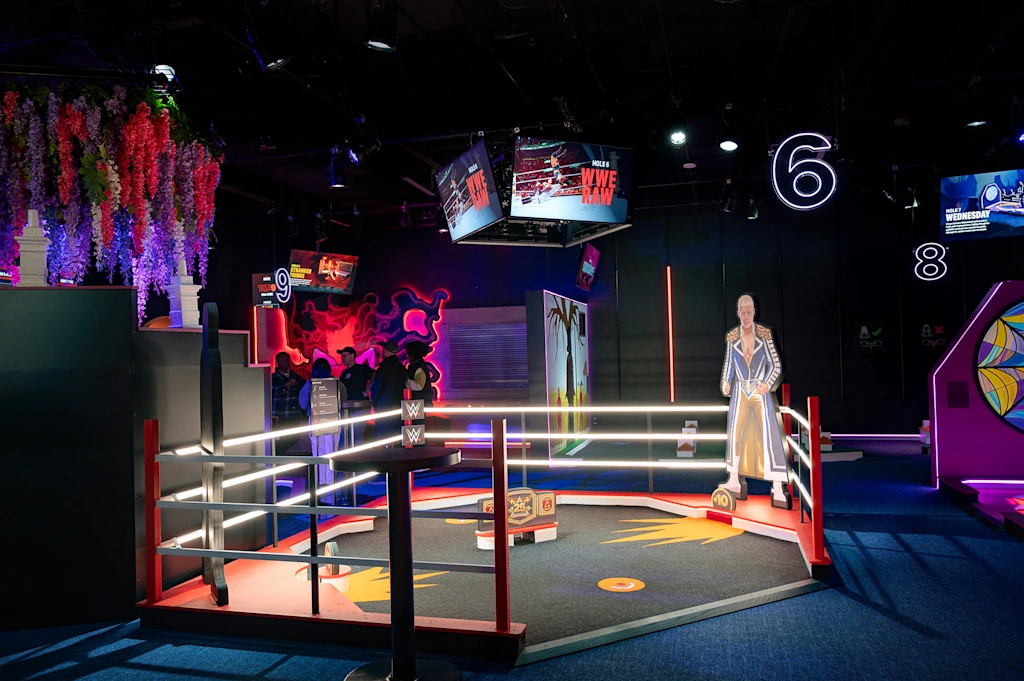
At night, a centrally positioned bar is sure to spill over into the attached Top Nine mini golf course, where the goal is to get a high score rather than low. Each hole represents a different show, and RFID balls mean your strokes are tracked automatically. A WWE hole urges you to bounce the ball off the ropes. An Is it Cake hole shows you a clip and makes you properly guess, is it cake? to get the highest score route opened. A One Piece hole actually places two putters against one other, head-to-head, each putting as fast as they can to fire cannonballs in a Skeeball-style arrangement to sink the other ship first.
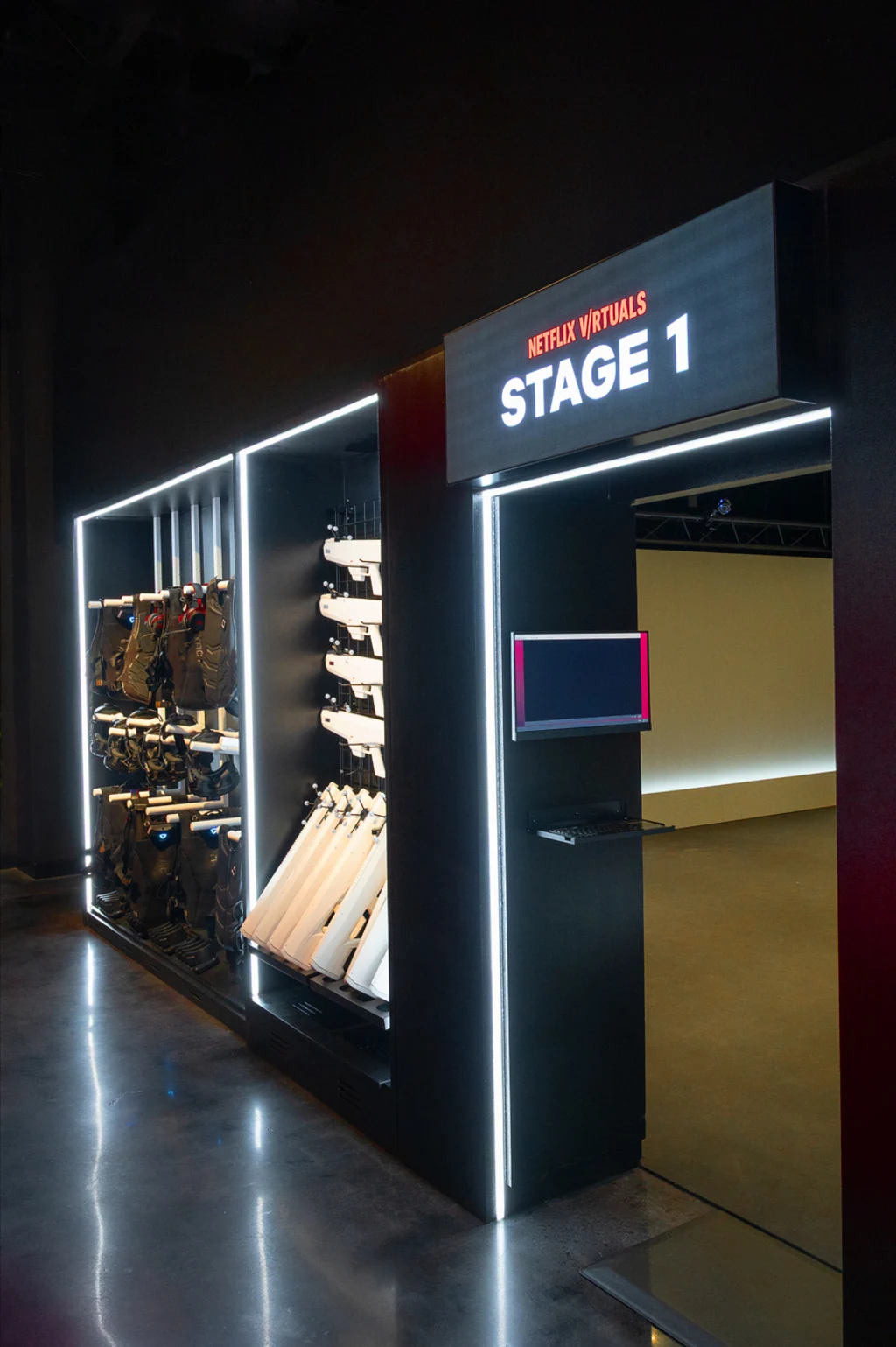
When I mentioned to Lombardo that I had my reservations about minigolf (seriously, minigolf?!?) at Netflix House, he counters that it’s actually been amongst the most successful pre-booked experiences. Indeed, even the actors being filmed for a promo do seem like they’ve having fun between takes. It only costs $15 to play a game, while the largescale experiences run $40 a head (or $160 for a family of four). These prices are within market rate for sure, but it’s notable that Netflix House has so many tiers of pricing for a visit: Free, $15, or rates that edge into day-at-a-theme-park territory when you mix live experiences with the price of dinner.
Finally, Netflix House features a roomscale VR setup created alongside Sandbox VR. It’s the one thing I didn’t really try, and the one bit of architecture that verged more toward looser scifi framing than Netflix IP (if you didn’t put the VR helmet on that is). Inside the VR world, you’ll be shooting the Demogorgon from Stranger Things.
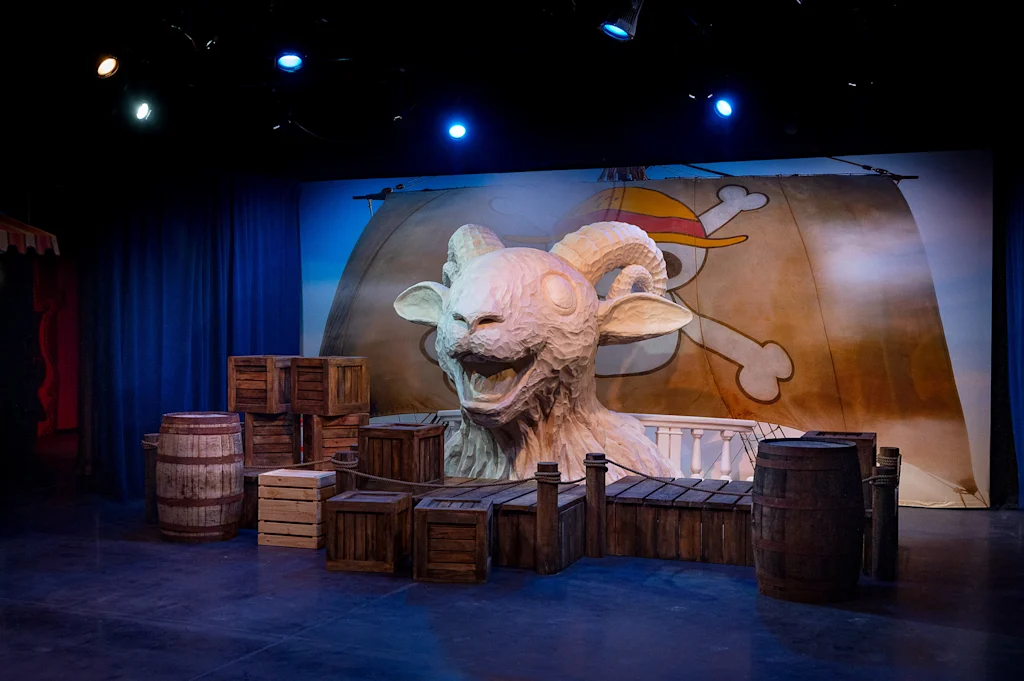
The future of Netflix House
I have little doubt that Netflix Houses opening in Philadelphia and Dallas this year, and Vegas (2027), will do well in the short term. Research shows that people will travel for live experiences—a recent report found nearly 50% of people would travel up to two hours for an immersive experience, and another quarter would travel up to three.
Netflix is one of the most impactful entertainment companies of the modern era. And it doesn’t just have the Netflix brand to stand upon. Its power comes from leveraging its ongoing cadence of viral IP into big box entertainment that’s designed to support the next big thing rapidly and fluidly.
Yet there’s no doubt that Netflix is dipping its toe into the water before completely jumping in. Lombardo tells me he feels pretty confident about the overall structure they’ve built, and their balance of entertainment options. But they do intend to keep learning and honing. When we spoke just days before the opening, he said his biggest unknown was actually around customer service. He wanted to ensure that, even in a space where you book tickets via QR code, every touchpoint with a Netflix House employee brought a fan deeper into the brand.
I think it’s reassuring that Netflix, a company known for digitization and scale, is focused on the human component—right down to the actors it’s hiring and training for its live experiences. I think about the ill fated end of Disney Quest—a 2000s-era attempt by Disney to reimagine the future of entertainment with arcade gaming but no live theater—as something Netflix must have learned from when modeling its own thesis. I found myself framing Netflix House as an AMC for the streaming age, or maybe Planet Hollywood with less crappy food and more actual stuff to do. Maybe even a third space for bored teens, minus the matcha.
Ultimately, the market will decide if Netflix House is a worthy idea or not. But I left the space feeling positively nostalgic, remembering the weekends I used to spend staring at a big screen in the dark with my feet sticking to the floor, or recalling the liminal interactions I had with actors in immersive theater shows like Sleep No More.
Netflix is embracing some of the most exciting trends in theater while mixing in some of the most popular IP of the era, all within a middle American friendly wrapper of a classic cineplex.
If Netflix is a master of anything, it’s creating a spectacle—and making it as easy to experience as possible.
